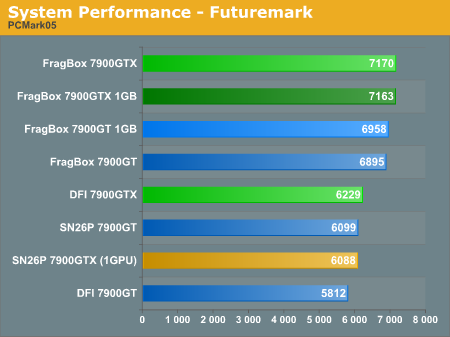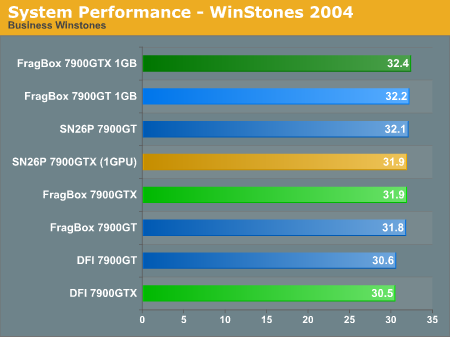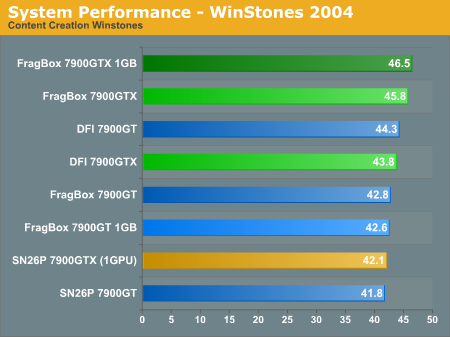Falcon Northwest FragBox SLI: Dare to Dream
by Jarred Walton on May 3, 2006 9:00 AM EST- Posted in
- Systems
System and Application Performance
We'll start with a look at system performance using several common business benchmarks. All of these tests are to varying degrees "synthetic" benchmarks, as user interaction is eliminated from the equation. For some tests (i.e. word processing, email, spreadsheets) the user is the primary bottleneck. In other tests like multimedia encoding, though, system performance can play a more significant role. We've included results for Winstones 2004, PCMark05, and Worldbench 2005. PCMark04 would not report a score on any of the tested systems, but this is a known problem with the benchmark when running on the fastest AMD dual-core processors. The third multitasking benchmark always reports a failure on the grammar test. In our experience, PCMark05 is more demanding of a system than PCMark04, and the scores are relatively similar, so this isn't a serious problem.



Winstones has a margin of error of about 3%, though it can be as high as 5% in regular testing. Most of the scores fall within the margin of error, and the faster hard drive subsystem of the FragBox almost certainly plays a small role as well. The end result is that all three systems, when comparably equipped, perform similarly. PCMark05 stresses the hard drive subsystem even more, with a couple test that measure maximum hard drive performance. There are also 3D rendering tests, accounting for the slight difference between 7900 GT and 7900 GTX configurations. The overall performance of the Falcon Northwest FragBox comes out on top by a small margin, which is important considering the price. We could almost certainly match performance if we used the same hard drive setup in our custom-built desktop system, but the main point is that the FragBox lives up to the promise of delivering performance matching that of the best desktop systems in a micro ATX form factor.
In terms of memory, having 2 GB of RAM versus 1 GB of RAM has little impact on these application benchmarks. That's not too surprising, given that none of these tests are designed to use more than 1 GB of RAM. Someone odd is the fact that the falcon Northwest system scores noticeably (about 10%) higher in the content creation benchmarks when equipped with the 7900 GTX cards. With the DFI system, the reverse is true: the 7900 GT configuration scores somewhat higher. We're at a loss to explain this discrepancy, as Winstones generally isn't affected by graphics card performance, short of using integrated graphics.
We'll start with a look at system performance using several common business benchmarks. All of these tests are to varying degrees "synthetic" benchmarks, as user interaction is eliminated from the equation. For some tests (i.e. word processing, email, spreadsheets) the user is the primary bottleneck. In other tests like multimedia encoding, though, system performance can play a more significant role. We've included results for Winstones 2004, PCMark05, and Worldbench 2005. PCMark04 would not report a score on any of the tested systems, but this is a known problem with the benchmark when running on the fastest AMD dual-core processors. The third multitasking benchmark always reports a failure on the grammar test. In our experience, PCMark05 is more demanding of a system than PCMark04, and the scores are relatively similar, so this isn't a serious problem.



Winstones has a margin of error of about 3%, though it can be as high as 5% in regular testing. Most of the scores fall within the margin of error, and the faster hard drive subsystem of the FragBox almost certainly plays a small role as well. The end result is that all three systems, when comparably equipped, perform similarly. PCMark05 stresses the hard drive subsystem even more, with a couple test that measure maximum hard drive performance. There are also 3D rendering tests, accounting for the slight difference between 7900 GT and 7900 GTX configurations. The overall performance of the Falcon Northwest FragBox comes out on top by a small margin, which is important considering the price. We could almost certainly match performance if we used the same hard drive setup in our custom-built desktop system, but the main point is that the FragBox lives up to the promise of delivering performance matching that of the best desktop systems in a micro ATX form factor.
In terms of memory, having 2 GB of RAM versus 1 GB of RAM has little impact on these application benchmarks. That's not too surprising, given that none of these tests are designed to use more than 1 GB of RAM. Someone odd is the fact that the falcon Northwest system scores noticeably (about 10%) higher in the content creation benchmarks when equipped with the 7900 GTX cards. With the DFI system, the reverse is true: the 7900 GT configuration scores somewhat higher. We're at a loss to explain this discrepancy, as Winstones generally isn't affected by graphics card performance, short of using integrated graphics.










32 Comments
View All Comments
segagenesis - Wednesday, May 3, 2006 - link
Obviously this wont be cheap, but what an interesting feat of engineering. For a SFF computer this should literally have flames shooting out the back.Gary Key - Wednesday, May 3, 2006 - link
If they had utilized a Pentium 955EE it would have had flames coming out from all directions. :) Just kidding, not really, but we found it amazing how well this case design took thermal requirements under consideration when utilizing SLI and a FX series processor.